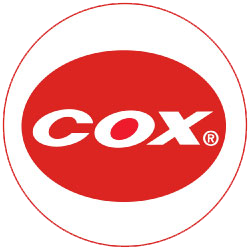
Cox Models, a former division of Estes Industries of Penrose, Colorado, was a multimillion-dollar hobby company, is one of the hobby industry’s oldest companies and is noted for its production of miniature model internal-combustion engines.
This company, originally named The L. M. Cox Manufacturing Co, Inc., was founded in 1945 by the machinist Roy Cox in Placentia, California. Cox grew up in and around his father’s bicycle shop, and he developed an interest in mechanical devices. Cox’s first products were wooden pop guns, produced in his home garage. Cox chose wood for his basic material, since metal was scarce during WW II.
When metals became readily available in the United States in 1947, Cox turned his attention to new products, beginning with a diecast metal car. This product was developed into a “whip car”, a tethered vehicle which could be manually swung in a circle at high speed. Nitro- and gasoline-powered tether cars with .60 cubic inch miniature engines capable of speeds of 100 mph (160 km/h) were quickly becoming popular. Cox’s first contribution to that growing hobby was a cast aluminum midget racer powered by a .15 engine by Cameron Brothers.
Cox Manufacturing enjoyed a large postwar growth due in part to its production of miniature model internal combustion engines and control line model aircraft, finally moving to a new factory in Santa Ana, California, in 1963. The factory started at 80,000 square feet (7432 square meters). Three expansions in a few years’ time saw expansion to 225,000 square feet (20,903 square meters) and introduction of a line of slot cars, model rockets, HO scale model trains, and a full-sized, one-horsepower gasoline-powered chain saw.
Roy Cox retired in 1969, and he sold the company to the hobby conglomerate “Leisure Dynamics”. Kites, toy walkie-talkies, and yo-yos were added to the Cox company products. A major step toward participation in the growing radio controled hobby business happened in 1976 with the acquisition of the radio manufacturer “Airtronics”.
By 1983, Leisure Dynamics was facing bankruptcy. Their engineer William Selzer, the designer of the “Babe Bee” .049 aircraft engine, joined with a local businessman to purchase the Cox company. The new company, Aeromil Engineering Company, changed the name of the company from Cox Company to Cox Hobbies, Incorporated, in 1984. Growth of the company continued, but its factory space became fragmented since the operations were spread out over a number of leased buildings. This prompted a move to a consolidated facility in Corona, California, in 1990.
In January 1996, a leading model toy rocket manufacturer, Estes Industries, purchased Cox Hobbies, Incorporated, and relocated operations from Southern California to the Estes facility in Penrose, Colorado. This signaled a major change in marketing direction for the new company, now known as Cox Models. A great many new products were aimed towards a mass market and they were sold in large chain stores and discount stores.
In February 2009 Estes Industries sold all of their remaining old classic Cox stock to several private buyers from the USA and Canada, one of them being a small privately owned company from Canada. In June 2009 they launched a website Cox International to sell their stock online and also via eBay. Some of the former Cox model train line is now sold by the Wm. K. Walthers company.
In January 2010 Estes-Cox Corporation was purchased by Hobbico based in Champaign, Illinois. These are the official owners of the former Cox name and logo and the Cox Models product line up consists of grand total of three basic Radio controlled electric trainer model airplanes.
To the present day Cox International continue to revive the original classic Cox brand of miniature aircraft engines as well as introducing new engine versions, reproduction parts, spare parts and accessories.
